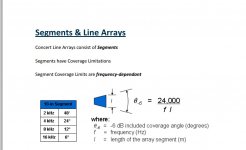I am considering building a set of esl's next spring.
I was wanting to build something close to 36"x72". I was wanting something that would look big and awesome sitting in my living room. But after reading through some of the posts it would seem that i would need a very large room to get quality sound.
I am also wanting to use them for watching movies and all around enjoyment. So instead of doing a curved set up would it be possible to build something like --> \_/ (three seperate panels the outside 2 angled) to get a wider sweet spot. I would assume that if i did it like that I could build 3 smaller panels but still get something close to the size i want.
any input.
i have a fairly large living room. like 14x28 or something close. have 2 other rooms they may go in as well that are larger than that.
i have a pretty good reciever and am hoping that would work to run them.
I was wanting to build something close to 36"x72". I was wanting something that would look big and awesome sitting in my living room. But after reading through some of the posts it would seem that i would need a very large room to get quality sound.
I am also wanting to use them for watching movies and all around enjoyment. So instead of doing a curved set up would it be possible to build something like --> \_/ (three seperate panels the outside 2 angled) to get a wider sweet spot. I would assume that if i did it like that I could build 3 smaller panels but still get something close to the size i want.
any input.
i have a fairly large living room. like 14x28 or something close. have 2 other rooms they may go in as well that are larger than that.
i have a pretty good reciever and am hoping that would work to run them.
Building a narrow panel will widen your sweet spot.
Adding wings will help a little bit to extend the low end.
All of this has been discussed recently in this thread,
http://www.diyaudio.com/forums/plan...st-esl-measurments-questions.html#post4053611
36" is much to wide!!
I think/know once you get a decent set made you will be more impressed as to how they sound rather than their size.
Do consider a hybrid system with a subwoofer, most any single dynamic woofer will be hard pressed to even keep up with a properly made and operating panel of just 6" to 12" wide and 48" tall to begin with when they are pushed hard.
Read through that thread and the links I have provided in it to give you somemore insight as it will then give you some more ideas as to which direction you would like to go.
Perforated Metal panel with a mechanically sectioned diaphragm or a electrically segmented stator design, and, what type of materials you are planning to use to build them.
Cheers!!!
jer 🙂
Adding wings will help a little bit to extend the low end.
All of this has been discussed recently in this thread,
http://www.diyaudio.com/forums/plan...st-esl-measurments-questions.html#post4053611
36" is much to wide!!
I think/know once you get a decent set made you will be more impressed as to how they sound rather than their size.
Do consider a hybrid system with a subwoofer, most any single dynamic woofer will be hard pressed to even keep up with a properly made and operating panel of just 6" to 12" wide and 48" tall to begin with when they are pushed hard.
Read through that thread and the links I have provided in it to give you somemore insight as it will then give you some more ideas as to which direction you would like to go.
Perforated Metal panel with a mechanically sectioned diaphragm or a electrically segmented stator design, and, what type of materials you are planning to use to build them.
Cheers!!!
jer 🙂
Last edited:
Here is the Formula I had mentioned to you in my PM for a good generalization of dispersion angle vs Frequency and driver width.
It is fairly accurate as it might not be as precise as the true formula but i did use this to do a few maps and they came out just the same as a spreadsheet that I had found and use for more accurate predictions now.
The spread sheet was much easier and faster to use than doing each point for the graph by hand!! He,he,he,he 🙂
The formula is found on page 6 of this document,
https://www.google.com/url?sa=t&rct...n4HAAw&usg=AFQjCNHUcKfnIVX3ZyZPZNlkU-w4mGoyow
The spreadsheets are called "Vertical Polar Response:line array" and "Asymmetrical Response
Pattern Estimator" VPR and ARPE and can be found here,
FRD Consortium
These tools are great and took all of the guessing work out of the question of dispersion.
jer 🙂
It is fairly accurate as it might not be as precise as the true formula but i did use this to do a few maps and they came out just the same as a spreadsheet that I had found and use for more accurate predictions now.
The spread sheet was much easier and faster to use than doing each point for the graph by hand!! He,he,he,he 🙂
The formula is found on page 6 of this document,
https://www.google.com/url?sa=t&rct...n4HAAw&usg=AFQjCNHUcKfnIVX3ZyZPZNlkU-w4mGoyow
The spreadsheets are called "Vertical Polar Response:line array" and "Asymmetrical Response
Pattern Estimator" VPR and ARPE and can be found here,
FRD Consortium
These tools are great and took all of the guessing work out of the question of dispersion.
jer 🙂
Attachments
Last edited:
- Status
- Not open for further replies.
